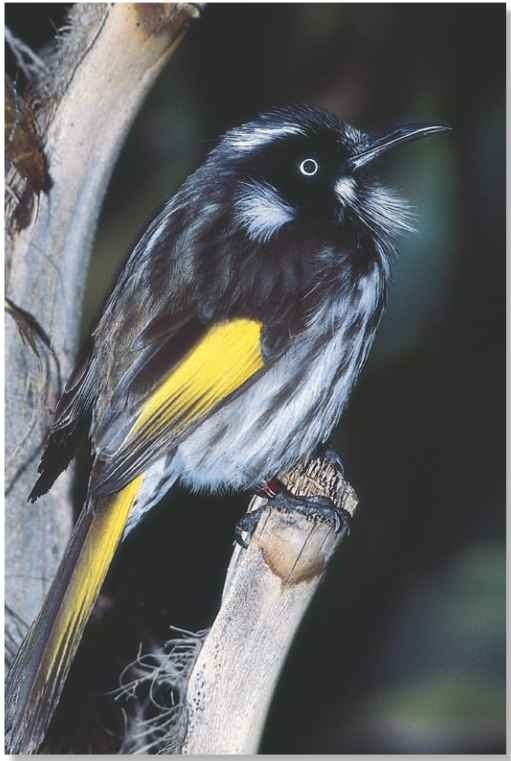ORDER
Passeriformes
FAMILY
Meliphagidae
GENUS & SPECIES
KEY FEATURES
• The brush-tip tongue of the New Holland honeyeater
lets it absorb all of a [flower’s nectar in less than a second
• A combative bird, it staunchly defends its nectar sources from other honeyeaters
• Spider webs help bind together a cup-shaped nest made mainly from bark, twigs and leaves
WHERE IN THE WORLD?
Found in southern Australia from 60-100 miles inland to the ‘ coasts of Victoria, southern Queensland, New South Wales, South Australia and Tasmania
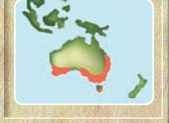
LIFECYCLE
Impatient and intolerant of other birds, the honeyeater stays alert to any intruders that might want to steal a sip of nectar from its favorite feeding grounds.
Habitat
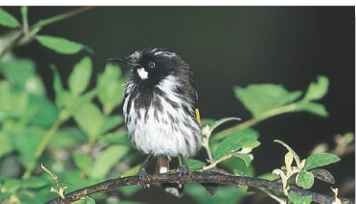
A woodland welcome
The varied terrain of southern Australia is home to the New Holland honeyeater.
The New Holland honeyeater establishes permanent residence in eucalyptus, banksia and melaleuca trees. The sweet nectar in the large banksia flowers makes this plant a prime choice of the honeyeater: In the bird’s woodland home, trees tower up to 75′, but low grassy and shrubby cover is abundant. The New Holland honeyeater also thrives in the coastal heath of southern Australia, where smaller evergreen and hard-leafed plants abound.
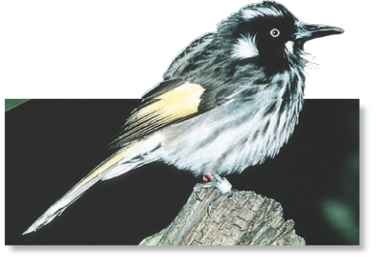
Very aware Ready to defend its nectar sources.
Food & feeding
The honeyeater’s remarkably efficient tongue gathers fluids from flowers in less than a second. Resembling an artist’s brush at the tip, the tongue extends into the nectar about 10 times per second; the sweet nectar adheres to the licking tongue. Nectar and fruits provide a carbohydrate-rich diet for the honeyeater, but it also supplements its diet with sugary insect secretions such as honeydew, a fluid excreted by aphids. Aphids suck the sap from leaves and excrete the honeydew from their thorax onto plants, leaving the honeyeater with a sweet snack. In order to balance its meals, it also eats insects, which provide protein and other nutrients.
Several different species of honeyeater may occupy the same range, each feeding on its own favorite flowers and insects. The New Holland honeyeater will staunchly defend its favorite plants from other honeyeaters and other species of small birds. Partial to bushy flowers such as the wooly banksia, the New Holland honeyeater will feed from them until the end of their flowering cycle, then use the dried down to line its nest. Despite this preference for fluffy plants, the honeyeater isn’t picky; it will feed from over 100 different flowering plant species.
Behavior
A belligerent bird, the New Holland honeyeater refuses to share its nectar supplies. It closely guards the many fluid-filled plants found in its territory from other New Holland honeyeaters and other smaller species. The bird flits restlessly from flower to flower and chatters loudly if disrupted. Honeyeaters occasionally gather for group displays, called “corroborees,” but given their usual quarrelsome nature, the reason for this assembly is unknown.
The New Holland honeyeater builds extravagant nests. The basic structure is made of twigs and leaves, but it is bound together and attached to its perch with pilfered spider silk, the universal cement of bird architects.The interior of the nest is lined with the down of the dried wooly banksia flower or other similar plants. The soft, secure nest is a luxurious home for the honeyeater
Conservation
Honeyeaters are one of the most populous bird families in Australia and are currently not threatened. The wide variety of nectars and insects that the honeyeater feasts on have enabled it to thrive in a variety of habitats. Several different species of honeyeater may often occupy the same range.
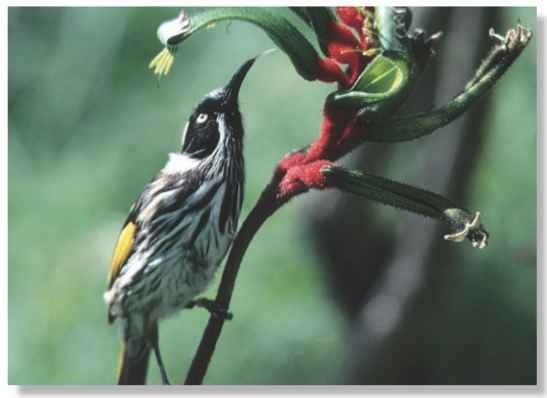
At least one species of honeyeater lives in every type of environment in Australia.
The further a honeyeater extends its tongue, the less efficient the tongue becomes.
Honeyeaters are important pollinators; they transfer pollen that clings to their feathers while flitting between flowers.
Artist at work Like a paintbrush, the tongue collects nectar.
Breeding
Since male honeyeaters usually outnumber females, they perform displays to attract a female during the breeding season. The male flaps in the air and emits a piping call before gliding in a steep descent to its perch. Once she has chosen a mate, the female builds a sturdy, cup-shaped nest, found 3-6′ above the ground.The pinkish-buff or white eggs are laid within three days, and incubated for two weeks. Both parents feed the hungry chicks their first meals of insects, and the chicks are ready to leave the nest in about two weeks.
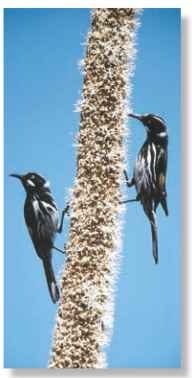
nesting needs
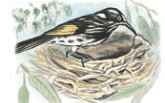
Building…
The cup-shaped nest is almost complete.The female adds a few more strands of grass to finish the lining of her creation.

Checking…
It has taken three days to lay a clutch of three pinkish white eggs. She inspects them before beginning her lone incubation.
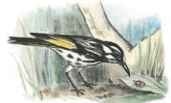
Gathering…
In 2 weeks the chicks have hatched.The male begins his parenting duties and collects insects for the chicks.
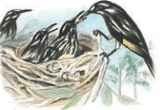
Feeding
The male feeds the chicks their high-protein meal while the female gets ready to take her turn gathering food.
PROFILE
New Holland Honeyeater
-The New Holland honeyeater is a speedy feeder as it darts from flower to flower, its tongue instantly absorbing nectar.
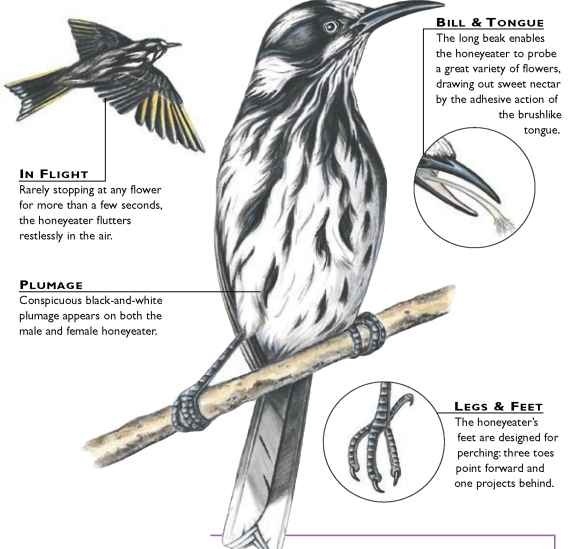
Creature comparisons
The white-fronted honeyeater (Phylidonyris albifrons) is about the same
size as the New Holland honeyeater with females smaller
in both species. Both honeyeaters have touches of yellow on their wings, with the white-fronted honeyeater showing a hint of red behind its eye in contrast to the distinct white iris on the New Holland honeyeaters black face. Both birds live in woodlands, but some white-fronted honeyeaters venture into areas the New Holland honeyeater
New Holland avoids, including arid shrubland and desert areas,
honeyeater
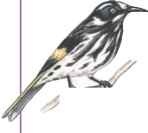
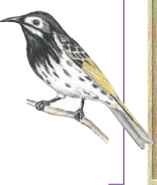
White-fronted honeyeater
| VITAL | |
| STATISTICS | |
| Weight | 1 oz. |
| Length | 6.5-7.5″ |
| Sexual Maturity | Unknown |
| Breeding Season | Year-round, except February |
| Number – of Eggs | 2-3 |
| Incubation Period | About 2 weeks |
| Fledging Period | About 2 weeks |
| Breeding Interval | Up to 3 times each year |
| Typical | Nectar, fruit, insects and insect secretions, including honeydew |
| Lifespan | Unknown |
RELATED SPECIES
• The order [ Passeriformes contains perching birds such as broadbills, warblers, larks and honeyeaters. The honeyeater’s genus, Phylidonyris, is one of 39 genera in the family, Meliphagidae. Phylidonyris contains six yellow-winged species, including the white-fronted honeyeater, ; P. albifrons, and the . white-cheeked hon: eyeater, P. nigra.
